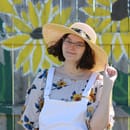If you love to read, odds are good that you have a system to track what books you’ve read. If that’s true, then odds are also good you have a Goodreads account. I, for one, made an account in 6th grade and was a huge fan for many years. You can track books, read and write reviews, find new recommendations—it’s an awesome website/app for readers!
However, there have been a number of issues with Goodreads that always bothered me, and I became increasingly aware of them like a thorn in my side as the years went on and nothing was changed. About two years ago I became aware of the website The StoryGraph, and thought it sounded pretty neat. Like Goodreads, you can track the books you’ve read, read and write reviews, tag books, and find recommendations. I spent a year using both The StoryGraph and Goodreads, logging books in both, and since then I have fully converted to The StoryGraph. I have now been exclusively using it since January 2021.
You might think, if they’re so similar, what’s the point in switching? Well, I have quite a few reasons.
To start, when reviewing books on The StoryGraph, there’s an (optional) feature to mark the mood(s) of the book as well as answer a few other questions, such as what the pace of the book was, and a few related to the characters. I find it really fun to answer those multiple choice questions, and when I’m looking for a book to read, I like seeing the data compiled for what people answered for each question. It’s especially useful to me, as someone who values strong characterization in a book, to see whether most people considered the characters loveable, considered character flaws a focus in the book, or considered there to be strong character development, all of which are covered by the multiple choice questions.
While this is very much a personal preference, I hate deciding how many stars to rate a book. I find it completely useless when choosing a book to read, and I’m inconsistent on my standards for what star I think a book is. Years later, I’ll never remember why I rated something 3 stars instead of 4, for example. I simply don’t understand it as a reviewing concept. On Goodreads, immediately after reading a book you are prompted to decide how many stars you’d rate it. This can be ignored, but I always felt so pressured to rate the books because the site shoves it in your face. On The StoryGraph, it’s designed much less intrusively so I never feel pressured to leave a star rating. The option is there when reviewing the mood of the book and answering the multiple choice questions, but I have a lot more fun, and find it a lot more useful, to focus on those questions and completely ignore giving the book stars.
That said, The StoryGraph is actually better when it comes to rating a book by stars, too. You can give half and quarter star ratings! Stuck between whether a book is 4 or 5 stars? Boom, 4.5 stars. Leaning towards 4 but not certain enough to just call it that? 4.25 stars! If star ratings are your thing, you’ll have a lot more flexibility rating books on The StoryGraph.
A few other reviewing features I haven’t used much but may be of interest to you are the ability to mark trigger warnings, note themes and tropes to improve recommendations for the book, and, of course, write full reviews for a book.
Another reason I prefer The StoryGraph is the data it provides on your logged books. Goodread gives some stats on books you’ve read, but The StoryGraph takes it up a notch. There are graphs and charts (especially pie charts) galore depicting info such as genres you’ve read, how many nonfiction versus fiction books, number of books and pages, most read authors, and the moods and paces of the books you read. You can even choose to view info for the whole year or for a specific month.
Next up, accuracy of recommendations. With Goodreads, the books it recommended to me have not changed once since 6th grade. No matter what books I read, I just kept getting weird romance books I’d never heard of that didn’t appeal at all. I don’t even read romance. Are The StoryGraph’s recommendations better? Well… somewhat. I still get a lot of recommendations that don’t make any sense, but I also get some in the genres and age groups I actually do read. They also change over time, instead of staying exactly the same. I still don’t rely on the website’s recommendations for finding new books very often, but it’s definitely an improvement.
What I really like in terms of finding books to read is The StoryGraph’s features for sorting through books you’ve marked To-Read. I have a very abundant To Be Read list, so it’s not usually a matter of finding new books I’ve never heard of to read, but one of choosing which book I’ve been wanting to read to actually pick up. The StoryGraph has a way to sort through that list based on the mood you want to read, fiction or nonfiction, pace of the book, and number of pages. Best of all, you can choose to only display books of a certain genre, or to not display any books of a certain genre (or multiple genres, for that matter).
Lastly, there’s the matter of who created/owns these websites. The StoryGraph is the book tracker that works best for me, but I also feel relieved to be using an alternative to a website owned by Amazon. The less I support Amazon, the happier I am. Using the StoryGraph gives less support to Jeff Bezos, and more to Nadia Odunayo, an up and coming entrepreneur. I’m very excited to see how her website continues to improve, as it was only in its beta version when I got it and it’s already gotten better and better.
If you’re ready to take the plunge and try out The StoryGraph, fear not that you’ll lose years of data from Goodreads. The StoryGraph actually has a feature to import your books from it! I have been much happier since switching to The StoryGraph, and I hope that you’ll like it just as much as I do.


